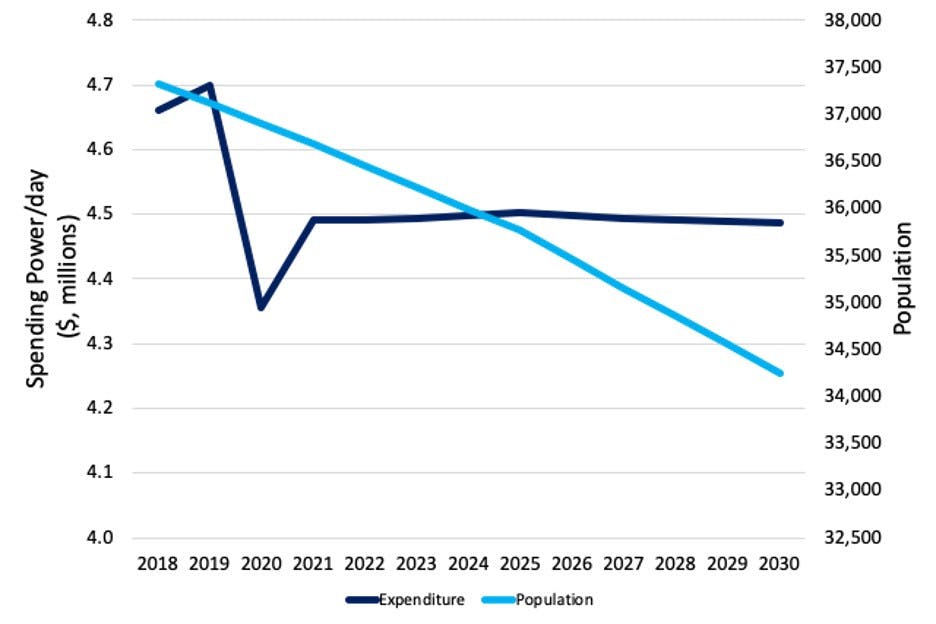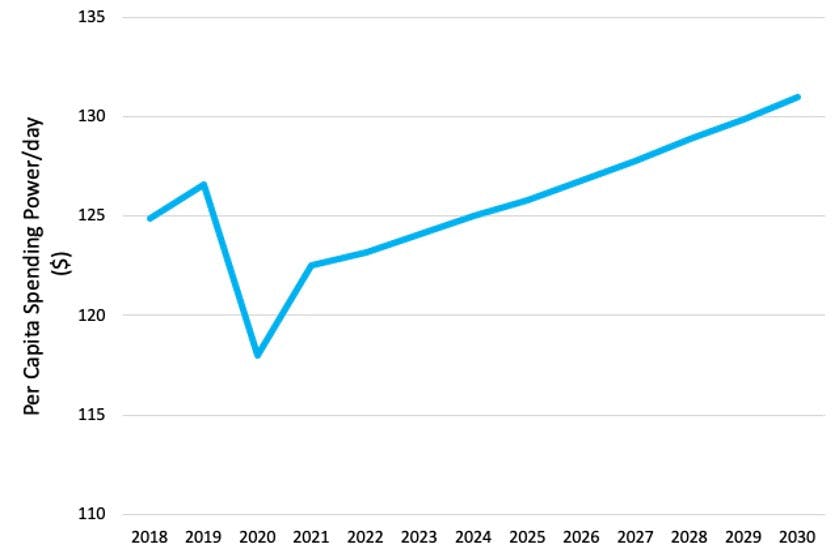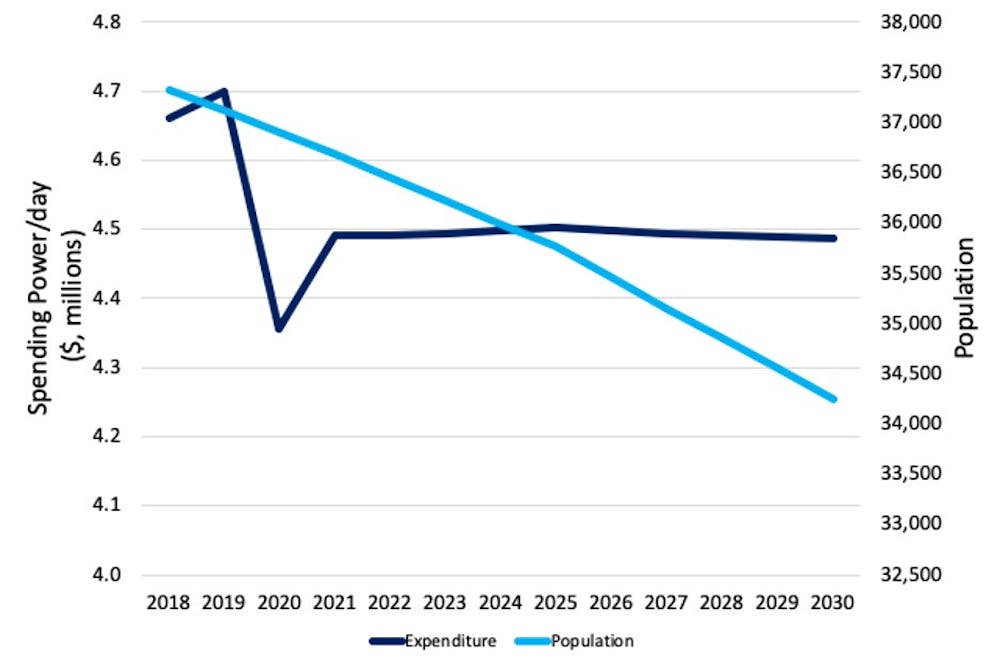Figure 1: Spending power and Population

The economic shock of Covid-19 will stifle consumer spending in Addison County this year, and it is projected to remain below pre-Covid levels through the next decade. Continued population decline in the county is likely to exacerbate this decrease in spending.
This summer, businesses in Addison County grappled with months-long closures due to the Covid-19 pandemic. Business owners reported that sales dropped as stores shifted to online operations and offered curbside pick-up or takeout. Although Vermont’s relatively low case count has allowed the state to reopen more successfully than others, financial recovery remains a far-off goal for many businesses.
Becky Dayton, owner of the Vermont Book Shop on Main Street, closed her storefront to customers on March 16 and shifted to an all-curbside delivery model. With the statewide shutdown, many of Dayton’s employees were unable to come in to work. “It was impossible for us to keep up with the business [with a reduced staff],” Dayton said.
Parts of downtown Middlebury were also closed for 10 weeks this summer due to construction of the tunnel for the Middlebury Bridge and Rail Project, which also may have contributed to decreased spending.
“My business has been down anywhere from 40% to 55% since March, and we have had to make really significant adaptations, but it's hard to put my finger on what of that was the pandemic and what of that was construction,” Dayton said.
Sales have slipped further with customers still reluctant to spend time in public spaces. Dayton said that she expects the shop’s sales to remain low for some time.
Still, economically, Addison County is managing the Covid-19 pandemic better than the rest of the United States. According to World Data Lab, a data company that produces spending and demographic forecasts, Addison County will see a 7.3% decline in consumer spending in 2020, slightly less than the 8.0% the US will see overall. While these numbers suggest that Addison county has done well with managing the Covid-19 crisis, the total spending power in the county will decrease significantly over the next decade.
If current trends continue, Addison County is projected to lose $800 million over the next 10 years, according to the World Data Lab forecasts. In 2020, Addison County residents will spend $125 million less than in 2019. Thereafter, the loss will level off at $73 million less per year compared with 2019 spending levels. This substantial and sustained decrease in expenditure could reasonably be accompanied with businesses shutting down in Addison County, smaller profit margins and revenues for businesses — or both.
While total consumer spending in the U.S. will recover by 2024, the projections suggest that Addison County will not see a recovery in the next 10 years. At least part of this decrease can be attributed to the broader trend of population decline in the county.
Vermont has implemented policies at the state and local levels to address the declining population and fill vacancies at Vermont businesses. The New Worker Relocation Grant Program offers people who move to and work-full time in Vermont grants of up to $7500 for relocation expenses such as first month’s rent, closing costs on a primary residence, shipping, hiring a moving company and more. Immigration and affordable housing advocates have also pushed for policies that encourage more people to settle in the state.
Figure 2: Spending power per capita in Addison County

According to World Data Lab, Addison County will recover from this recession in 2026 when spending power per capita reaches pre-Covid numbers. Furthermore, spending power per capita will increase by 3.3% from the recovery in 2026 to 2030.
When comparing the spending power per capita and the total spending power numbers for Addison County, it is evident that Covid-19 has and will continue to have a big impact on the county. However, a more lasting problem is the rapidly declining population.
Addison County’s population is among the top 10% of fastest declining populations in the US, with a projected 7% decline from 37,000 today to 34,000 by 2030. While the population in Addison County has been constant for the last 20 years, it will likely see a sharp decline in the next 10 years and drop to its lowest numbers since 1994. This decline in population is why total expenditure in the county is projected to broadly stagnate for the next 10 years.
Addison County has been able to sustain a low number of Covid-19 cases, but this pandemic may have triggered the stagnation of consumer spending over the next decade. The decline of the population will ultimately be the reason that Addison County is projected to lose $800 million over the next decade.
Although on an individual level, people in Addison County will be better off in 2030 compared to 2019, the county itself will not see a full recovery. With less money being spent in the county over the next 10 years, it seems inevitable that businesses, particularly small businesses, have a difficult era ahead.

Tony Sjodin ’23 is a managing editor.
He previously served as community council correspondent, senior writer, news editor and senior news editor.
Sjodin is majoring in political science with a focus on international and comparative politics. He previously held internships with the Appalachian Mountain Club's Outdoor Magazine, political campaigns in Massachusetts and Vermont, and the U.S. Embassy in Costa Rica's Environmental Hub. Outside of class, he leads kayaking and hiking trips with the Middlebury Mountain Club.




